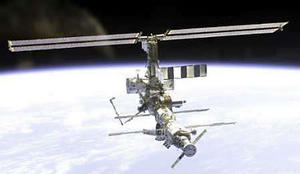At the request of NASA, the US military has now used spy satellites to examine the International Space Station and see if it has suffered any damage that might explain the huge metallic sound heard there a week ago by the astronauts aboard the station
 The space agency learned a lesson from the Columbia disaster. "We are all convinced that nothing happened to the station, but let's be sure that we didn't miss anything. NASA is now stressed, so it has taken steps it might not otherwise have taken," said Charles Percourt, a shuttle commander who currently serves as NASA's deputy director of the space station program.
The space agency learned a lesson from the Columbia disaster. "We are all convinced that nothing happened to the station, but let's be sure that we didn't miss anything. NASA is now stressed, so it has taken steps it might not otherwise have taken," said Charles Percourt, a shuttle commander who currently serves as NASA's deputy director of the space station program.
Percourt said the Defense Department had been using its technology to monitor the station since the noise was reported on Nov. 26. Due to the obfuscation of the nature of the work carried out by the military, he would not say whether NASA had been able to obtain any satellite or ground-based telescopes that would shed light on the problem, but only said that so far nothing unusual has been found.
Astronaut Michael Powell and cosmonaut Alexander Clary, who have been on the station for a month and a half, used the robotic arm and the station's cameras to examine the exterior of the Russian-made residential quarter, but the devices cannot reach every corner.
Among the possible explanations given by NASA: a loose or wobbly antenna, or a loose cover or piece of space junk that hit the station. By the way, this version has confirmation from observers of the Russian army who photographed an unidentified piece of shrapnel near the station. "We are trying to dig and understand what the source of the noise is," says Percourt. "As of now, we have no conclusion.
The two on the station were asked to perform an in-depth inspection during the spacewalk they will perform in February. Percourt said, however the spacewalk has not yet been approved due to the fear of leaving the station unmanned even for a short period of time.
There are usually three people inside the station, but the crew was reduced to two due to the grounding of the space shuttle fleet.
Foal and Clary had just woken up in the Russian living area when they heard a noise that sounded like hitting a piece below. The air pressure, however, remained stable and all the other systems at the station worked perfectly fine.
Powell, who was on the Russian Mir space station when the supply vehicle collided with it in 1997, said that he is convinced that there is no breach in the station. "It didn't happen this time." Percourt says that the station staff sometimes hears "voices in the night" and they know about them. "This noise was unique." said.
Immediately after the Columbia disaster, NASA and the Army's Mapping and Imaging Agency announced that they would routinely take satellite photos of shuttles in orbit and of the station. When Columbia was in orbit, engineers asked to take photos of the shuttle to check the damage caused by the piece of foam that fell from the external fuel tank during takeoff. However, NASA managers refused to request this from the Pentagon.
